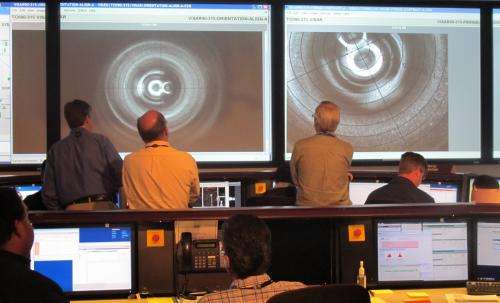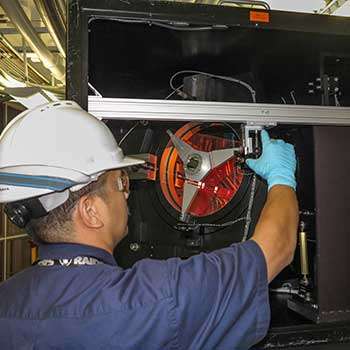Measuring NIF's enormous shocks

NIF experiments generate enormous pressures—many millions of atmospheres—in a short time: just a few billionths of a second. When a pressure source of this type is applied to any material, the pressure wave in the material will quickly evolve into a shock front. One of NIF's most versatile and frequently-used diagnostics, the Velocity Interferometer System for Any Reflector (VISAR), is used to measure these shocks, providing vital information for future experiment design and calibration.
Invented in the 1970s, VISAR was developed by Sandia National Laboratory scientists to study the motion of samples driven by shocks and other kinds of dynamic pressure loading. It has since become a standard measurement tool in many areas where dynamic pressure loading is applied to materials.
"It is a big challenge to figure out how to apply these enormous pressures without immediately forming a shock wave,' said Peter Celliers, responsible scientist for VISAR. "Instead of trying to avoid forming shocks, many NIF experiments use a sequence of increasing shocks as a convenient way of monitoring the performance of the target as the pressure drive is increased—for example, during a (target) capsule implosion."
To measure these shocks, VISAR determines the speed of a moving object by measuring the Doppler shift in a reflected light beam. More specifically, it directs a temporally-coherent laser beam at the object, collects a returned reflection, and sends it through a specially-configured interferometer. The interferometer produces an interference pattern containing information about the Doppler shift.
The Doppler shift provides information on how fast the reflecting part of the target is moving. In most cases the reflector is a shock front, which acts like a mirror moving through a transparent material (for example liquid deuterium, quartz or fused silica). In some cases the moving mirror is a physical surface on the back part of a package (called a free surface) that is accelerated during the experiment. In yet other scenarios, the moving mirror could be a reflecting interface embedded in the target behind a transparent window.

After the light reflected from the target passes through the interferometers, it forms a fringe pattern. With the NIF VISAR design, this light is collected in the form of a two-dimensional image with an optical image relay system. The fringe pattern is superimposed on the image, then projected on the slit of a streak camera. Because the target image is spatially-resolved across the slit of the streak camera, this type of VISAR is called a line-imaging VISAR. The spatial and temporal arrangement of the fringe pattern in the output streak record reveals how different parts of the target move during the experiment.
There is a very close connection between the velocities of the moving parts of the target and the pressure driving the motion. If the velocity is measured accurately, a highly accurate picture of the driving pressure can be formed. This information is vital for understanding the details of target performance.
"Our simulation models are not accurate enough to calculate the timing of the shocks that produces the best performance without some sort of calibration," Celliers said. "But by monitoring the shocks with the VISAR, we have precise and detailed information that can be used to tune the laser pulse (the pressure drive) to achieve optimal target performance, and to calibrate the simulation codes."
Looking to the future, VISAR will see improvements to its streaked optical pyrometer (SOP), an instrument that can be used to infer the temperature of a hot object by measuring the heat radiated from the object in the form of visible light. The SOP is undergoing modifications to improve its imaging performance and to reduce background levels on the streak camera detectors. This will benefit future equation-of-state experiments where accurate thermal emission data is crucial. This upgrade will be complete in early 2015.
Provided by Lawrence Livermore National Laboratory



















